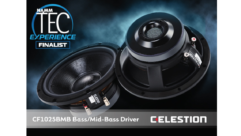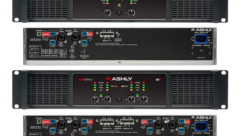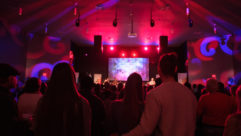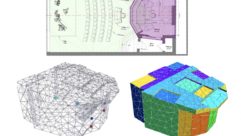FREQUENCY CROSSROADS
Sep 1, 2000 12:00 PM,
Jay Mitchell
A close look at a variety of crossover topologies will allow the systems installer to predict the effect of specific crossovers on real-world loudspeakers.
The necessity for dividing the audible frequency range into multiple bands is taken for granted in most loudspeaker applications. Although certain aspects of this subject are likely to be familiar, it is a good idea to summarize the motivations for splitting the audio spectrum. First, the bandwidth of almost every useful transducer is inadequate by itself to meet the bandwidth requirements for a complete loudspeaker. Further, the directivity of a single transducer (or horn/driver combination) will not be sufficiently consistent with frequency to meet reasonable goals for the directivity of a full range loudspeaker. Finally, the maximum available acoustic output of a single transducer is often inadequate by itself. In this article, we will examine the characteristics of a number of crossover filter topologies with the goal of predicting the effect of various crossover types on the performance of a practical loudspeaker.
Crossover function
A good starting point is to state as simply as possible the functional requirements that should be met by a crossover network – a crossover should enable the acoustic sum of the individual transducers’ outputs to be an accurate replica of the system input signal. The response of a loudspeaker, for purposes of this article, is defined to be its pressure response at a particular point in space.
Even though the above criterion is simple to state, there may be constraints that lead to tradeoffs in a loudspeaker’s accuracy. For example, prevention of damage to transducers is often an over-riding consideration in the design of a crossover. This may motivate the designer to consider steeper filter slopes. In some loudspeaker configurations, off-axis response anomalies are intrinsic to the design. The designer may wish to make off-axis anomalies in amplitude response as symmetrical as possible. The Linkwitz-Reilly filter family is sometimes chosen in pursuit of this objective.
The simplest crossover possible is a first-order filter pair. In a two way loudspeaker, the first-order transfer functions for lowpass and highpass functions are:
F subscript l = (v subscript 0)/(s + v subscript 0), and F subscript h = s/(s + v subscript 0)
where F subscript l is the lowpass transfer function; v subscript 0 (= 2pf subscript 0) is the angular cutoff (-3 dB) frequency; s is the Laplace complex frequency variable, and F subscript h is the highpass transfer function. If we add the two transfer functions, we get:
F subscript t = (s + v subscript 0)/(s + v subscript 0) = 1
In other words, the two transfer functions add to a constant independent of frequency. This is a desirable result because the outputs of the radiators in a multiway loudspeaker are ultimately recombined by acoustic addition. The transfer function of our electrical sum implies that, in a two-way loudspeaker with ideal, coincident transducers and a first-order crossover, the system transfer function would not depend on frequency. We could, with some effort, engage in the same exercise with higher-order transfer functions. We would find, however, that of all symmetrical linear filters, only the first-order pair does not introduce phase or amplitude error or both to the loudspeaker’s transfer function.
A treatment of the mathematics of crossover interactions is beyond the scope of this article. The interested reader may find mathematical analyses of crossover topologies in the references. I have chosen, instead, to use electrical circuit simulations to illustrate the summation behavior of a number of different crossover topologies.
Two-way crossovers
The chart in Figure 1 is the summed electrical response of a first-order crossover (trivially, a Butterworth alignment). For simplicity, the crossover frequency has been set at 1 kHz. The choice of crossover frequency causes no loss of generality. Note that the result is as predicted above – there is neither amplitude nor phase error present in the summed response of these filters.
Figures 2, 3 and 4 are amplitude and phase plots for second-order Butterworth, second-order Butterworth with high-frequency polarity reversed, and fourth-order Linkwitz-Reilly crossovers, respectively. Each is a two way configuration with 1 kHz crossover frequency. The outputs have been added electrically. Note the amplitude notch in Figure 2, the amplitude peak in Figure 3, and the phase changes in all three of these filter combinations.
Another way of looking at the behavior of the filters we are considering is to examine the system response to an impulsive input signal. Figures 5, 6, 7 and 8 show the responses of the various crossover topologies to a signal with short rise time (100 ns) and short duration (100 ms). Note again the ideal behavior of the summed first-order filter pair. The response of the second-order Butterworth with high-frequency polarity reversed is of particular interest – the initial portion of the output signal is negative-going in response to a positive-going input.
The response of each family to a 500 Hz square wave is presented in Figures 9, 10, 11 and 12. Also, the response of each system to a 500 Hz tone burst is shown in Figures 13, 14, 15 and 16. As above, the response of the polarity-reversed high-frequency makes itself evident in Figure 15.
Closer to reality
The preceding simulations, while instructional by themselves, are somewhat removed from real-world conditions. There remains a question of how well the simple simulations above predict crossover performance in actual loudspeakers. It is possible to introduce elements of a practical loudspeaker’s behavior into our simulations.
Because human hearing has a bandpass characteristic and because the best realizable loudspeaker will be a bandpass filter, we constructed an electrical bandpass filter. Lower and upper cutoff frequencies are 50 Hz and 15kHz, with lowpass and highpass slopes both being second order (12 dB/octave). Figures 17, 18 and 19 show the response behavior of t his bandpass filter. The impulse response is noteworthy; the longer rise time of the response is due to the 15 kHz lowpass characteristic. I would not expect a real loudspeaker to have a significantly better attack characteristic than that shown in Figure 18.
The response or our bandpass circuit to a 500 Hz square wave input is shown in Figure 19. The output appears to overshoot, followed by a droop in the flat portion of the input signal. This is caused by the highpass portion of the loudspeaker’s response. Once again, it should be understood that a real loudspeaker’s response to a square wave should not be expected to look better than this.
Simulations of transducer transfer functions
Having developed a feel for what constitutes best-case target behavior in a real-world loudspeaker, we can proceed to take our simulation exercise one step closer to the real world. We have approximated the response of low- and high-frequency transducers with fourth-order bandpass functions. In the following simulations, the low frequency bandwidth is 50 Hz to 2 kHz, and the high frequency bandwidth is 500 Hz to 15 kHz. The output of the crossovers is applied to the input of the appropriate bandpass filter, and then these cascaded signals are added. For reference, the summed response of the transducer bandpass functions with no filtering is shown in Figure 20. In the case of first-and second-order systems, the crossover frequency has been shifted upwards from 1 kHz. Note the decidedly non-ideal system transfer function of the first-order filter set with the bandpass functions added, and note the apparent superiority of the second-order mat ched-polarity system in Figure 22.
Given only the above information, it would be tempting to conclude that the second-order Butterworth provides the best performance in a two way loudspeaker with transducers similar in bandwidth to our model filters. This conclusion, however, is not necessarily supported by additional data.
The impulse responses of these systems are presented in Figures 24, 25, 26 and 27. In Figure 24, the impulse responses of low-frequency and high-frequency filters are shown separately. The additional delay in the output of the lowfrequency section is evident in this graph, and the shape of the system impulse responses all show some effect of this delay. The first-order system appears to offer an advantage over the other topologies in this series of graphs. For reference, the responses of each system to a 500 Hz square wave are shown in Figures 28, 29 and 30.
It is clear that in each of the above cases the output of the low-frequency section is delayed relative to that of the high-frequency. This is not surprising; the delay is caused by lowpass function in the simulated low-frequency transducer response. Information from the simulations was used to establish a high-frequency delay for each topology. Additionally, crossover frequencies were shifted to optimize various aspects of each system’s behavior. The resulting 500 Hz square wave responses are shown in Figures 31 ,32 and 33.
Delay settings were shifted experimentally after the initial determinations in an attempt to optimize the square wave response of each filter set. Delay for the first-order crossover was set at 135 ms, second-order at 230 ms, and fourth-order L-R at 480 ms. No experimentation was performed on the reversed-polarity second-order system. The optimal-delay impulse responses are shown in Figures 34, 35 and 36, and transfer functions for each of the three topologies are presented in Figures 37, 38 and 39.
Another filter topology that has the same summation characteristics as the first-order Butterworth is the constant-voltage family of filters. One of the filters in a constant-voltage crossover transition may be of arbitrary alignment and slope. The complementary filter is derived by subtracting the first from the full-range signal. The electrical summation characteristics of this filter family are trivially obvious in: F subscript s(1 – F subscript s) = 1.
For this reason, graphs of the electrical sum of this filter family are identical to those of the first-order Butterworth. The filter that is derived by subtraction always has 6 dB/octave stopband slope and usually has a peak in its passband. The magnitude of the peak depends on the slope and alignment of the complementary filter. Figures 40, 41, 42, 43 and 44 are the transfer function, 500 Hz square-wave response, impulse response, low-frequency response and high-frequency response, respectively, of a constant-voltage crossover derived from a second-order Butterworth highpass with 1.5 kHz cutoff frequency. As with the other simulations, delay was optimized (135 ms) for the 500 Hz square wave shape. The crossover filter outputs are cascaded with the same bandpass filters that were used in previous simulations. The performance of the constant-voltage crossover topology is similar to that of the first order Butterworth, with the added advantage of a steeper slope for one of the two filters.
Multiway systems
The addition of a third element to the spectral split introduces an additional complication that may not be intuitively evident. The midrange filter set has two components, a highpass and a lowpass. The lowpass filter introduces delay in its passband that affects the lower crossover transition (i.e., low frequency to mid frequency). For this reason, the electrical sum of the crossover filters alone deviates from the predicted behavior for a two-way system. A three-way Linkwitz-Reilly simulation is shown to illustrate this effect, but every topology except constant-voltage suffers
from these effects.
The crossover frequencies in Figures 44, 45 and 46 are 200 Hz and 1,500 Hz. As individual system passbands become narrower, the delay caused by the lowpass portions of the bandpass filter sections will have a greater effect, and the response ripples evident in Figure 44 will become deeper.
Passive crossovers
All of the above considerations are quite easily applied to active crossovers because the power amps serve as buffers between the crossover and loudspeaker. With passive crossovers, the loudspeaker designer’s task can be somewhat more complex. The impedances of the transducers employed in most loudspeakers vary significantly with frequency, so the design of filters that apply the intended voltage to the transducers’ inputs is a nontrivial exercise. Almost all electrodynamic transducers have a prominent peak in the impedance curve at the frequency of mechanical resonance. In the case of high-frequency units, this frequency can occur close to the crossover frequency, which makes its presence all the more problematic. Horn/driver combinations often have additional impedance peaks caused by internal reflections and other acoustic reactances. There is also usually a gradual rise in impedance with frequency above resonance that resembles that of an inductor. All of these phenomena have an effect on the load a passive crossover’s output must drive and, therefore, on the voltage applied to the transducer’s input.
Among the options available to the loudspeaker designer, one of the more easily implemented is a parallel network to stabilize the impedance of the transducer to a relatively constant value across the frequency range of interest. Regardless of the circuitry employed, the designer must do his predictive work with specific knowledge of the impedance behavior of each of the transducers involved in the design. Because this parameter has the same effect in production as tolerances in the values of circuit components, it is also wise to include transducer impedance measurements in QC testing.
Digital filters in crossover design
Recently, a number of DSP-based signal processing units have become available. In the digital domain, filter functions are realized by adding the product s of successive individual signal samples (called taps) and sample-specific weighting factors. Two general families of DSP filters are possible- infinite impulse response (IIR) and finite impulse response (FIR). Of the two, only the IIR family is currently in use for crossover filters in commercially available products. This filter family’s characteristics are, in general, identical to those of readily implemented analog filters. For this reason, the preceding discussion of crossover filter behavior is directly applicable to all of the presently available DSP-based crossovers. Performing analog-type filter functions in the digital domain, while it may seem anticlimactic, has the one formidable advantage of total immunity to problems associated with component tolerances. Additionally, all of the current crop of DSP-based crossovers include band delay, limiting and equalization functions.
FIR filters offer a number of options not available in analog filters. Practically realizable slopes may be almost arbitrarily steep (slopes of 100 dB/octave or more are not uncommon), and phase change within a filter’s passband may be rendered virtually nonexistent. A crossover based on FIR filters can also potentially correct or substantially reduce certain non-minimum phase transducer phenomena as well as those having minimum phase characteristics.
One major drawback is, however, present in the use of FIR filters. The total signal delay in a crossover using FIR filters can be (but is not necessarily) unacceptably large. The delay caused by the introduction of an FIR filter into a signal path is the product of the number of taps in the filter and the sampling interval (one divided by the sampling frequency). Lower cutoff frequencies, steeper slopes and minimum stopband ripple all require larger numbers of taps, so the total delay introduced by a crossover having FIR filters depends on the specifics of the crossover parameters. This can create problems when, for example, models of a manufacturer’s loudspeakers having different crossover parameters and, therefore, differing signal delays, are used together in an array. This sort of potential problem can be anticipated and addressed in the design phase of a product family, but the designer must be aware of the implications of the use of FIR filters.
It is reasonable to expect that, in the future, DSP-based crossovers, particularly those developed for specific loudspeakers, will make increasing use of FIR filter topology. Off-the-shelf units, however, can be expected to mimic analog filter functions for some time to come.
Conclusion
The data presented here make it clear that, in comparing the attributes of various possible crossover topologies, there is a strong correlation between predictions based on t he simplest model – electrical summation of only the crossover filter outputs – and more realistic scenarios in which transducer transfer functions are accounted for. The technique of evaluating electrical summation properties, therefore, is useful in qualifying possible filter topologies for use in a loudspeaker. In order to evaluate the combination behavior of a specific filter set accurately, it is necessary first to compensate for any delays caused by the transfer functions of individual drivers.
Although the transfer function characterization contains a complete description of a filter system’s linear behavior, certain aspects of system performance are more easily visualized through the use of transient input signals. Even a relatively idealized model of a loudspeaker – a bandpass filter with a broad passpand – shows obvious imperfections in passing transient signals well within the system’s bandwidth. Because the types of measurements that yield transient response data are often not feasible to perform on a loudspeaker, advance knowledge of the effect of a filter topology’s effect on a system’s transient behavior is essential for design purposes.
Higher-order symmetrical crossover filters cause a system to suffer from degradations in transient response. Additionally, such filters cannot be optimized both for transient behavior and amplitude response. Maximizing performance in one area requires that corresponding sacrifice be made in the other. Only the constant-voltage varieties, including first-order Butterworth, allow optimization of both domains simultaneously.










